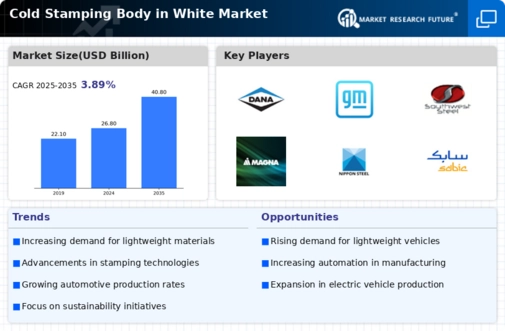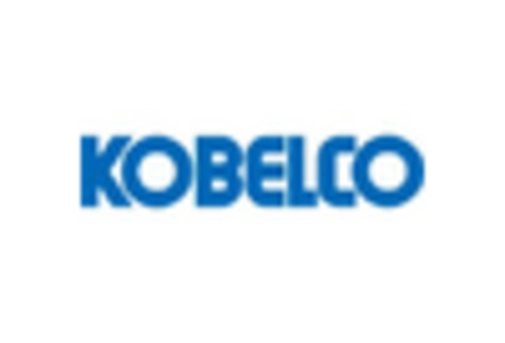Market Growth Projections
The Global Cold Stamping Body in White Market Industry is projected to experience substantial growth over the next decade. With a market value of 26.8 USD Billion in 2024, it is anticipated to reach 40.8 USD Billion by 2035. This growth trajectory suggests a compound annual growth rate of 3.89% from 2025 to 2035, indicating a steady increase in demand for cold stamping technologies. Factors such as rising automotive production, the push for lightweight vehicles, and advancements in manufacturing processes are likely to contribute to this positive outlook. The market's expansion reflects the evolving landscape of the automotive industry.
Growing Automotive Production
The Global Cold Stamping Body in White Market Industry is experiencing growth driven by the increasing production of automobiles worldwide. As automotive manufacturers ramp up production to meet consumer demand, the need for efficient and cost-effective manufacturing processes becomes paramount. Cold stamping, known for its ability to produce lightweight and durable components, is gaining traction. In 2024, the market is projected to reach 26.8 USD Billion, reflecting the industry's shift towards advanced manufacturing techniques. This trend is expected to continue, with the market potentially reaching 40.8 USD Billion by 2035, indicating a robust growth trajectory.
Increasing Focus on Electric Vehicles
The shift towards electric vehicles (EVs) is significantly influencing the Global Cold Stamping Body in White Market Industry. As automakers transition to EV production, the demand for lightweight and high-strength components becomes crucial to enhance battery efficiency and overall vehicle performance. Cold stamping provides an effective method for producing these components, aligning with the industry's focus on sustainability and innovation. The growing investment in EV technology is expected to drive the market forward, as manufacturers seek to optimize their production processes to accommodate the unique requirements of electric vehicles.
Rising Demand for Lightweight Vehicles
The demand for lightweight vehicles is a significant driver of the Global Cold Stamping Body in White Market Industry. As fuel efficiency regulations tighten globally, automotive manufacturers are increasingly adopting lightweight materials to enhance vehicle performance and reduce emissions. Cold stamping offers a viable solution, enabling the production of high-strength components that contribute to weight reduction without compromising safety. This trend aligns with the industry's broader sustainability goals, as manufacturers seek to meet consumer expectations for environmentally friendly vehicles. The anticipated growth in this sector is likely to bolster the market, supporting its expansion in the coming years.
Technological Advancements in Cold Stamping
Technological advancements in cold stamping processes are reshaping the Global Cold Stamping Body in White Market Industry. Innovations such as automated stamping lines and advanced die design are enhancing production efficiency and precision. These advancements not only reduce manufacturing costs but also improve product quality, making cold stamping an attractive option for automotive manufacturers. As companies invest in modernizing their production facilities, the market is expected to benefit from increased adoption of cold stamping techniques. This trend is likely to drive growth, as manufacturers seek to leverage technology to remain competitive in a rapidly evolving industry.
Regulatory Support for Sustainable Manufacturing
Regulatory support for sustainable manufacturing practices is a key driver of the Global Cold Stamping Body in White Market Industry. Governments worldwide are implementing stringent regulations aimed at reducing carbon emissions and promoting environmentally friendly production methods. This regulatory landscape encourages automotive manufacturers to adopt cold stamping techniques, which are known for their efficiency and lower environmental impact compared to traditional methods. As manufacturers align their operations with these regulations, the market is poised for growth, with projections indicating a compound annual growth rate of 3.89% from 2025 to 2035, reflecting the increasing emphasis on sustainability.























Leave a Comment